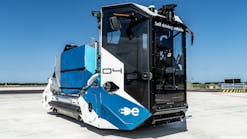It’s like peanut butter and jelly, Sherlock and Watson; completely different, but completely dependent on the other for a great success story. Airports and ground handlers need each other.
It’s a relationship that is so intertwined and yet, complex. They bring unique qualities and services to their customers, the same people expecting a smooth, incident-free experience as they enter the airport doors.
While the names of the airport and ground handler are also different, in the customers’ minds, they are the same. It is the overall package that matters, and to make that work, airports and ground handlers need to communicate, address challenges head-on, but most of all, have each other’s backs in an environment built on mutual trust and teamwork.
A Common Mission
“Southwest Airlines and the airports depend on each other for our partnership to be successful,” echoes Chris Johnson, senior director of ground operations at Southwest Airlines. “It takes both entities. We have a common goal to provide a safe environment and customer-friendly travel experience for our passengers.”
Terry Blue, vice president of operations at Memphis International Airport (MEM), says it is essential for airports and ground handlers to recognize that passengers have options and they will go to a different carrier, or even airport, if they are met with inconsistent service. At MEM, the ground support companies are tenants, but operate under an operating permit which says they must abide by MEM’s rules, regulations and standards of safety.
Johnson, who has worked in more than 10 airports during his career with Southwest, says the close relationship the airline continues to have with its peers exists because they don’t allow relationships to become strained.
“It’s in our best interest to make sure the customer’s experience is great,” he notes, adding that when a customer buys a ticket on a specific airline, it’s that airline whose reputation is at stake.
Blue agrees, and says the airport recognizes that their reputation is on the line too, especially in today’s competitive flying environment where airports and airlines want to be the top choice. As an example, Blue says one of his colleagues no longer flies with a specific airline because of a challenging experience many years ago.
“It certainly does last,” he says of a company’s impression. “She uses that in her daily job to remind her of the constant mission to take care of the customer first. If you would talk to many of the folks that I work with here, they all understand that message.”
Johnson says at Southwest they use the word “hospitality” because it reflects the highest level of customer service.
“It’s more than just a transaction,” he says. “It’s how we treat our customers.”
This message is carried to both employees in the airports and those involved with the aircraft itself. He says the airport teams really focus on ways to improve services such as baggage handling and safety, and encompass all these things into a very professional standard of operations for Southwest as a whole.
There are Challenges
Johnson of Southwest explains one of the things that must be balanced – and something that takes effort – is the airport’s standards versus the Southwest standards of operation and customer service. He understands the airport must remain a neutral entity because they are working with many carriers and yet have their own standards.
“They might just not be able to honor the things you want,” he says from the airline perspective. “They do a really good job of not playing favorites.”
He says that at all airports, Southwest employees must be badged, whether working inside or outside. Driving rules, deicing policies, etc., vary from location, as does the way an airport administers its policies.
There are also differences in working with smaller airports and larger facilities, Johnson explains. The policies and procedures may be similar, but the message must also be expanded to a much larger group of staff say at, Memphis versus a regional airport.
In order to keep all these fine lines in order, Southwest actually employs a separate Standards Department, tasked with ensuring all the policies and procedures at each airport are up to date, known by the station managers and then followed. With 101 airport clients, this is no small task, but an essential one for Southwest to maintain a high level of service.
Ben Leischner, airline scheduling manager at Seattle-Tacoma International Airport (SEA), explains that at Sea-Tac, safety requirements are very proactive and more conservative than any of those put in place by the airline partners.
“Due to recent litigation for accidents and injuries on the ramp, airports have gained a liability for maintaining safety on our ramps,” he says. “One aspect of this is defining standardized approaches to the use and allocation of ramp space.”
A unique challenge for Memphis, notes Blue, is the short travel distance from some of the gates’ jet bridges to the baggage carousel. He says the first person coming off the plane could find themselves settling in for a 20-minute wait and that it’s entirely possible that when the bags arrive, the last person on the last row of the airplane is still onboard.
“Perception is something we have to manage,” he explains.
There is no ‘I’ in Team
Perception is something all air travel entities must manage, and this is where the teamwork becomes so vital to success.
MEM’s Blue says that during his career as an airport executive, both in Milwaukee and Memphis, he’s been blessed to see ground handlers really take on a teamwork approach.
“They recognize we are all in this together; we will all succeed or fail together,” he says.
Leischner agrees, he says that Sea-Tac has always utilized a highly collaborative approach of being transparent as well as open-minded when enacting policies that affect air carriers and the way their operations function at the airport facilities.
“It is a constant and open line of communication, as we continue to have a record number of operations here at Sea-Tac, which is now the ninth busiest airport in the country,” he notes.
Johnson says he started with Southwest as a ramp agent, then has worked his way throughout the company in several different positions, including leadership roles at the airport stations. This background has given him a lot of time to work with airport executives, serve on boards and is the reason why he is confident in saying that the relationship must be a true partnership.
“We have a common goal of making sure we’re safe, the customers are safe and they are taken care of while traveling,” Johnson explains.
He says this was proven to him the day he was working in a major airport and the baggage handling system went out of service during a busy travel period.
“The airport really stepped up and assisted us in every way possible,” Johnson boasts. “We actually had to move bags through the airport in the same areas passengers traveled in. The airport extended out all their employees and assisted us in ensuring we kept operations in those terminals while transporting bags too.”
Southwest checks the most bags of any carrier, 20 million a year, according to Johnson. Of those, he says 99.8 percent arrive as scheduled. So that baggage handling system malfunction was a major issue – and would be for any airport, airline or ground handler.
Johnson says the teamwork that day spoke to a true partnership, not playing favoritism and working toward a common goal.
Blue says there are days when an airport deals with these irregular operations, and another challenge is when diversions from neighboring airports are being sent in.
“You need true teamwork to tackle airplanes landing left and right,” he says. “You’re definitely going to need your ground handlers because they will make or break you.”
Maintaining Communication Matters
In order to ensure passengers have a positive experience, Southwest’s Johnson says communications must flow through multiple levels and engage with the airport at all times.
Southwest headquarters has an Airport Affairs Department, which communicates with airport leadership on items such as rates, charges, leases, space, etc. Then, at the local level, Southwest has leaders at each airport location.
“They are the grassroots people who on a day-to-day basis interact with the airport entities, attending regular meetings and assist in ensuring our spaces are adhering to the standards of the airport at the local level,” Johnson explains.
Blue confirms this from the airport perspective and says that while the airlines hire all ground handling resources for MEM, the station manager attends meetings and is responsible for all airport standards being met.
Each month, MEM has a Customer Service Action Committee meeting. Blue says that while operational issues are addressed, of course, there is a deliberate focus on customer service in that meeting of station managers for all airlines and ground handling companies.
Like any other business, he says the one between ground handlers and airports is about relationships.
“It’s about having that 1:1 relationship and knowing how to call, when to call and being certain they will jump in and help – all recognizing that as a team we can accomplish so much more,” Blue concludes.








